(32nd & 46th Regiments
of Foot)
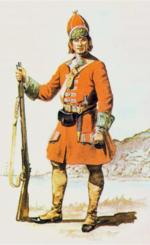
A Private of Fox's Marines (Charles
Stadden)
This regiment was first raised in
1702 as Fox's Regiment of Marines, then numbered
as the 32nd Foot in 1751. The 46th was raised
in 1741 as Price's Regiment, in 1782 the 32nd
was affiliated to Cornwall and the 46th to South
Devonshire. in 1858 the 32nd was designated as
a light infantry regiment to commemerate its defence
of Lucknow during the 140 days of Indian Mutiny
siege in the previous year, eighty seven days
of this period the regiment was alone..
At the outbreak of the Indian Mutiny
the 32nd (The Cornwall) Regiment was stationed
at Lucknow. By the 30th June 1857 the regiment
in the face of vastly superior numbers of mutineers
was forced to withdraw into the Residency. Despite
intense heat, severe casualties and the ravages
of cholera, the Regiment withstood constant attacks.
It was not until the 18th November that Lucknow
was finally relieved. Casualties amounted to 15
officers and 364 other ranks dead and 11 officers
and 198 other ranks wounded. Civilian casualties
were also numerous. The Regiment was to win 4
Victoria Crosses for gallantry during the seige.
Her Majesty Queen Victoria directed
that - "In consideration of the enduring
gallantry displayed in the Defence of the Residency
of Lucknow, the 32nd Regiment be clothed , equipped
and trained as a Light Infantry Regiment from
26 February 1858".
The Union Flag over the Residency
is the only one which is not struck at sundown.
It flies and has flown since the mutiny, day and
night.
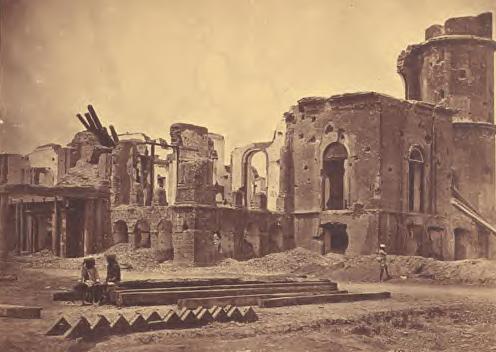
The Residency in Lucknow - 2
years after the end of the Mutiny
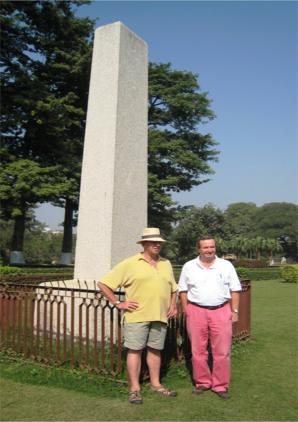
Picture taken on 18 Nov 2007
on the 150th Anniversary of the Relief of Lucknow
at the DCLI Lucknow Memorial - on the left the
late Captain Richard Hogg with Brigadier Gage
Williams
In 1881 the regiments were linked
as 1st & 2nd Battalions The Duke of Cornwall's
Light Infantry. Reduced to a single battalion
in 1948 and amalgamated with the Somerset Light
Infantry in 1959 to form The
Somerset & Cornwall Light Infantry
During 1884, the D.C.L.I. was stationed at Dublin,
where its men would be sent after four months
training at the newly-built depot at Bodmin, Cornwall.
The Regimental Museum has photographs of all the
recruits of the time, but unfortunately, they
are not named. In 1885, the First Battalion moved
to Malta, and three years later, on 18th February
1888, they moved to India, arriving in Madras
on 7th March.
In 1890, rebellion broke out in Burma, led by
a tribe known as the Tsawbaws. The First Battalion
were moved to Mandalay, and the following year
took part in what became known as the Wunthoo
Expedition which successfully quelled the revolt.
They then returned to India, doing garrison duty
successively at Pur and Roorkee (1893), Chakrata
and Meerut (1894) and Lucknow (1896). In 1897
a campaign was fought on the North-West Frontier
in which the Battalion took part in the Tirrah
expedition, seeing active service in Tirrah and
the Bara Valley.
During the next two years they were stationed
at Peshawar, Rawal Pindi and Lucknow (1898-1899)
and Calcutta and Dum-Dum (1900).
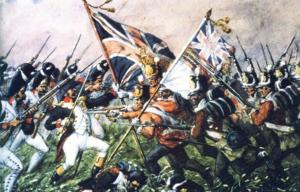
During the Battle of Waterloo
a French officer attempted to seize the King's
Colour of the 32nd but was run through by Sgt.
Switzer's pike and Ensign Birtwhistle's sword.
In 1901, prisoners of war from South Africa were
shipped over to Ceylon to hastily constructed
camps, and the First Battalion was given the task
of guarding them. The following year they sailed
for South Africa as part of the army of occupation,
and were stationed at Stellenbosch (1902), Middleburg
and Cape Colony (1903) and Wynberg (1904-05).
In 1906, the Battalion returned to England where
they were initially quartered at Crownhill Barracks,
Plymouth. From there they moved to Woolwich (1907),
Gravesend (1908-1910) and Tidworth (1911). In
1913 they were back in Ireland in Curragh and
they mobilised for war on 5th August, 1914. They
took part in every major battle on the Western
Front.
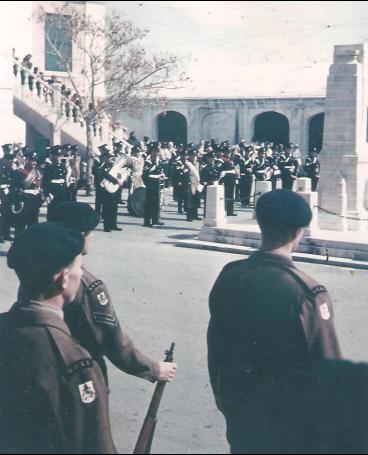
DCLI .Peppercorn Ceremony, St
Georges Bermuda 1956 - A Coy-Band-Bugles. Original
Photo taken by Mrs Marsh Company Commanders Maj.T
Marsh Wife.
DCLI. Peppercorn Ceremony Bermuda
The Peppercorn Ceremony is one of
the highlights of the year in St George and was
one of the many parades that DCLI carried out
during its tour in Bermuda.
Facings:----- White, ----Motto: One and all:
from that of the County of Cornwall
Nicknames:--- The Red Feathers (46th): from Paoli,
and the Docs: from the Duke of Cornwall.
Customs: ---The Loyal Toast was drunk once a
year in the Officer's Mess. This was on the sovereign's
birthday and commemorated the shortage of wine
during the seige of Lucknow.
Bodmin Depot - DCLI
The old Barrack Blocks at Victoria Barracks,
Bodmin (the home of the Duke of Cornwall’s
Light Infantry) are now converted into private
homes, However, the roadway in front of these
new homes! That saw thousands of recruits forming
up for muster and passing our parades for so
many years, is now sign posted and named “ROYFFE’S
WAY” a fitting tribute to a legend. RSM
Royffe.
|
|
|
A mid terraced two bedroom house located
in the recently converted Grade II Victoria
Barracks retaining many character features
|
20 man rooms either side of doorway
with another two at top of stairs. At
the time, 1960 I thought this was the
doorway to the level below Hell.( Comment
by Tony Hood who supplied the pic taken
in 2007)
|
|
|
|
Guardroom, where our uniforms were
inspected before being let loose on
Bodmin. on the opposite side were the
cells (never saw the inside of those.)
now a office for Recruiting. (Comment
by Tony Hood who supplied the pic taken
in 2007)
|
The way they were.
|
Bandsman Thomas Edward Rendell VC
Thomas Edward Rendle VC (14 December 1884 –
1 June 1946) was an English recipient of the
Victoria Cross, the highest and most prestigious
award for gallantry in the face of the enemy
that can be awarded to British and Commonwealth
forces.
He was 29 years old, and a bandsman in the 1st
Battalion, The Duke of Cornwall's Light Infantry
- on 20 November 1914 near Wulverghem, Belgium,
Bandsman Rendle attended to the wounded under
very heavy rifle and shell fire and rescued
men from the trenches in which they had been
buried from the blowing in of the parapets by
the fire of the enemy's heavy howitzers.
Rendle later achieved the rank of sergeant.
After World War I, he emigrated to South Africa
where he became bandmaster of the Duke of Edinburgh's
Own Rifles.
His Victoria Cross is displayed at the Duke
of Cornwall's Light Infantry Museum in Victoria
Barracks, Bodmin, Cornwall.

This painting was presented to members of Rendell
platoon of the Royal School of Music
Information and image supplied by Rex Brain
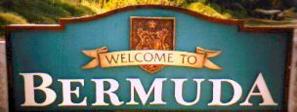

Duke of Cornwall's Light Infantry Association
Contact: The Keep, Victoria Barracks, Bodmin, Cornwall, PL31 1EG, Tel: 01208 72810
Also see Michael Hargreave Mawson's excellent site on the 46th Foot
|

